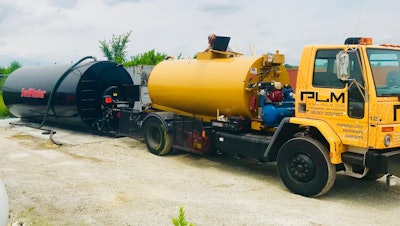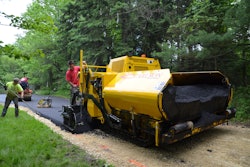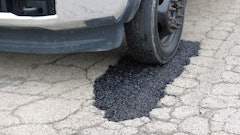
Like many aspects of running a profitable sealcoating operation, whether or not to have a refillable storage tank in your yard is based on logistics and economics. If you are only doing small jobs, if your sealer supplier is nearby, and if sealcoating is not a major part of your business then you probably are fine picking up sealer from your supplier as you need it. If that’s not the case, then you might want to consider a yard tank.
When to Use a Yard Tank
Lee Lowis, vice president at GemSeal, says questions to answer when considering a yard tank include:
- What is the distance to a supplier or distributor?
- How much sealer do you use in a year? A month?
- Are there enough cost savings in labor hours and material price to offset the cost of the tank?
- Will you use an entire load of sealer in one year? If you do not, what will you do at the end of your season with the remaining product?
“In many cases, the distance to the supplier and the convenience of having material available when you need it, not when your supplier is open, is enough to justify a tank,” Lowis says.
Bill Maclean, at The Brewer Company, says most suppliers will place a tank in your yard if you buy a certain amount of sealer. “Suppliers depend on volume and will work with you on storage tanks,” Maclean says.
Most manufacturers charge a slight fee to provide the tank, but some just require the contractor buy a certain volume of sealer and then they’ll provide one.
“We need to know that a customer will use at least three loads with each load valued at $10,000-$13,000 before we’ll provide a tank,” says Bob Krebs, owner of South Carolina and North Carolina SealMaster franchises. “Those people are usually out in the hinterlands, too far away from a regular pickup,”
Tony Heffernan, regional vice president at Neyra Industries, says the company has a cutoff point before they’ll provide a tank. “We want to know they’re going to do a certain amount of gallons, say more than 30,000,” he says.
Maclean says advantages of having a tank in your yard include you can load when you want, you don’t have to rely on someone else’s business hours, there’s a cost savings in material, and less travel time to pick up sealer.
He says there are disadvantages, too, including you have to maintain the tank like any piece of equipment; you have to order, store and inventory additional materials such as additives; and yard tanks pump slower than a supplier’s tank.
“Suppliers pump at about 45-50 gpm and a yard tank will pump at about half that rate. That can be a factor,” Maclean says. “But if you go through the majority of your sealer on weekends and if you are distant from your supplier, a yard tank might be worthwhile.”
Buying Your Own Tank
Even if your company doesn’t meet the qualifications for a manufacturer to supply a tank, any contractor can still buy and install their own tank and manufacturers will deliver sealer as needed.
“If they’re getting 15,000 gallons a year as a pickup customer they should be considering buying their own tank,” Heffernan says. “It will probably pay for itself in two years or at the most three years. That’s when guys can really turn their business around and grow faster because it immediately increases their bottom line.”
Maclean says tanks can cost $20,000 depending on their size and are available in 6,000-, 8,000- and 10,000-gal. capacities. “The more volume you do and the farther away you are from your supplier the larger tank size you’ll buy,” Maclean says.
Is Your Yard Tank-Ready?
Before ordering a tank there are a number of boxes to check off.
First among them is, will your state, city or county allow you to have a sealcoating tank in your yard?
“Check with your local officials to see if there are any zoning or other restrictions on placing a tank at your desired location,” Lowis says.
But Maclean cautions that it might take a few calls to get the correct answer. “There seldom is an ordinance that spells this out [relating specifically to pavement sealer], so it’s up to the various departments that it might impact,” he says.
“There are plenty of situations where somebody wanted a tank in their yard but some part of the city came back and said ‘No.’ Sometimes it’s an ordinance the contractor wasn’t aware of, sometimes zoning, maybe it’s the fire department. What people need to remember is there’s usually not just one department that handles it.”
Maclean suggests checking with the city’s economic development office because they’ll know what other departments might become involved and they’ll have access to the departments that have an interest in it. “An economic development office probably will be more inclined to be helpful since you’re a business in their city,” he says.
Lowis says contractors also need to find out if there are any road or street restrictions that limit the weight of a truck that would be making a delivery. Then make sure your yard can accommodate the delivery truck.
“Delivery trucks are large; people underestimate how big they are,” Lowis says. “Does your location allow for the delivery truck to get close enough to the tank? Make sure that the truck will not be blocking traffic and that the yard entrance has enough space for the truck to make any turns to get in and that the truck can get out safely.”
Once you have approval of the public agency and know that access roads will support a delivery, it’s time to locate the tank in your yard.
Where to Place Your Tank
The tank needs to be situated in a place where it can be delivered and positioned so it can easily be refilled and so your crew can easily fill applicator equipment from it. The path from the street to the tank has to be able to support the delivery vehicle and the area the tank sits on has to be able to support the tank with a full load of sealer.
“You’ve got 80,000 lbs. rolling into your yard so it also needs to be a good solid base to get to the tank location,” Krebs says.
Make sure to leave room so the delivery truck, which measures about 8 ft. x 8 ft. x 20 ft., can get in and out easily.
“You’ll have an 18-wheeler drop off the tank and then the supplier will come in with a road tanker to fill the yard tank,” Krebs says. “Remember, we’re not talking about the turning radius of a Ferrari. You need a lot of space for the tractor-trailer to maneuver.”
Maclean says that when determining a tank location contractors should think in terms of a semi-trailer, not a single-axle truck. “If the delivery tanker can’t get in and out of the yard you’ll have to move the tank,” he says.
Heffernan says that about 25% of those who have a Neyra tank have placed their tank inside a building that can be heated during the winter. “That helps with spill containment, helps with aesthetics by putting the tank out of site, and it makes cleaning the tank very easy,” he says. “If it’s inside all you have to do is fill the tank to the top, leave it in a heated building, and agitate it regularly. But the delivery vehicle has to be able to get to tank.”
Krebs advised that, “Once you have a location, find out the state or local laws regarding leakage. Some states require building a dam around the tank.” Heffernan says putting a tank inside a building can solve that problem. However, Krebs cautioned that, “One South Carolina town would not even let the contractor place a tank on the ground or inside his building.”
“In some states you might need 110% containment around the tank so that if the tank completely emptied out by accident it would be contained,” Heffernan says. “So an 8,000-gallon tank would need 8,800 gallons of containment.”
Provide Yard Access
Jeff Luzar, vice president of sales at Guardtop, says suppliers and contractors handle this differently but it’s essential the delivery vehicle have access to the yard when the supplier shows up to make a delivery.
“They don’t want to have to wait for you and don’t want to have to call you,” Luzar says. “If you can’t have someone there to accept a delivery then provide them a key.”
Krebs says to make sure the tank is secure. He says it should be behind a locked fence, the manhole should have a lock, and he recommends disengaging the motor if possible so the tank won’t pump.
Tank Configuration and Care
Tanks can be powered by gasoline or by electricity. Maclean says gasoline-powered tanks are noisier, so if the tank is near a residential area an electric tank might be better. “Electrically operated tanks are usually quieter than gasoline,” he says.
Electric tanks can also be set up with a timer, which helps assure material is agitated regularly. “Yard tanks need to be agitated daily. If nothing else it’s a good habit to get into,” Maclean says. “If the tank has a relatively low volume and sits for two weeks that’s going to be a problem.”
Krebs warned that the downside of automated agitation is if something happens and you aren’t there to check on the tank. “We know of one customer with automated agitation that accidently left a valve and pump engaged. When the timer kicked in, the unattended tank pumped 4,000 gallons onto their warehouse floor”. The automated system solves one problem but could create another. It’s best to check on the tank daily,” Krebs says.
Suppliers note that even though tanks are owned by the supplier and provided free or at a minimal cost, it’s the contractor’s responsibility to maintain them as if they owned them. “That means keeping them filled with gasoline, greasing them, maintaining the pump, keeping the hose clean, making sure the material is agitated regularly, and cleaning out the tank before spring,” Krebs says.
“Consider your yard tank as part of your own equipment and take care of them as you would your own,” Luzar says.












![Lee Boy Facility 2025 17 Use[16]](https://img.forconstructionpros.com/mindful/acbm/workspaces/default/uploads/2025/09/leeboy-facility-2025-17-use16.AbONDzEzbV.jpg?ar=16%3A9&auto=format%2Ccompress&fit=crop&h=135&q=70&w=240)








